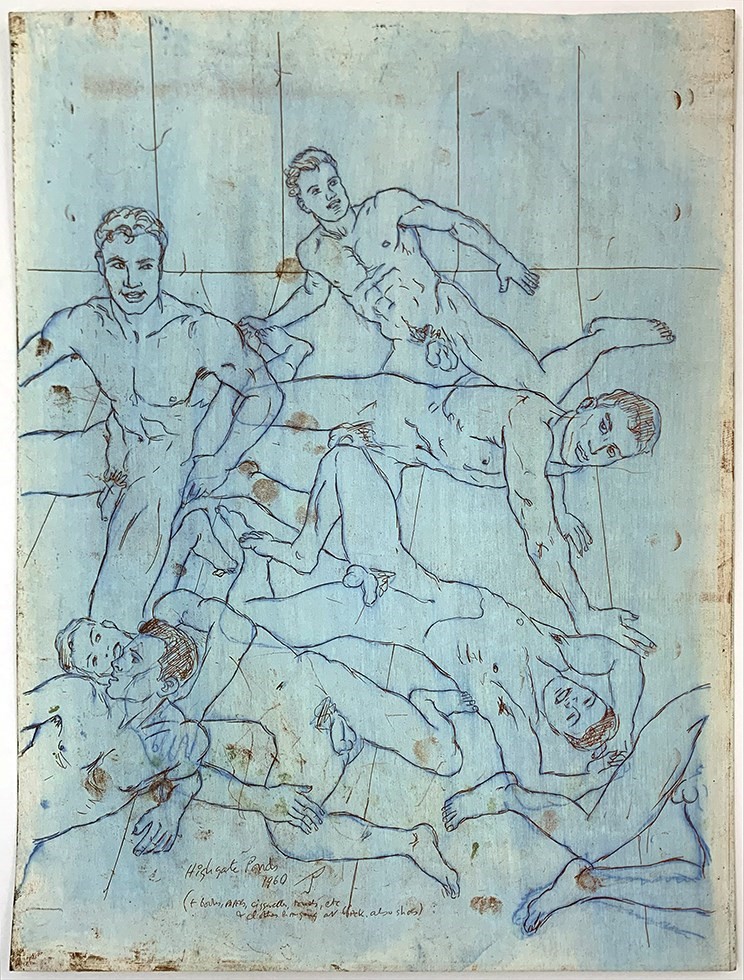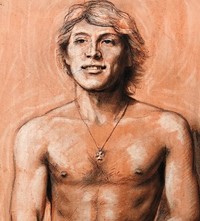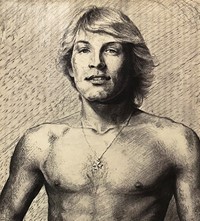Barrington’s drawings and sculptures of the male body made him the godfather of physique photography, and saw him arrested for his ‘obscene’ work
- TextMiss Rosen
Tales from another time... In a new series, titled Illicit Histories, Miss Rosen tells the stories of queer art’s pioneers, unpacking the lives and work of people who revolutionised gay erotic imagery – often in defiance of censorship laws.
Artist, photographer and family man John S. Barrington (1921-1991) was a true eccentric, crafting a double life as the godfather of British physique photography who openly flouted the UK’s strident anti-homosexuality laws while vehemently denying he was gay.
In 1938, Barrington, then 17, took up photography as a young art student, making figure studies of lithe young men. Barrington insisted his fascination with the male body was an integral part of his artistic process, his photographs becoming the basis for images then used to create drawings, silverpoint, and sculptures – yet Barrington also slept with the very men he photographed.
“Barrington was able to justify his life, existence, and behaviour by conceptualising it like an alter-ego or split personality, as though the married guy with children and the promiscuous pornographer were two separate people within the same body,” says gallerist Brian Paul Clamp. “I think the photography came out of his desire to have these sexual relationships. At times it seemed as though the photography was an aside, but he also considered himself a ‘fine artist’ and was frustrated that he never received recognition for his work.”
Instead of public accolades, Barrington was targeted for flouting the law. In 1949, two undercover policemen arrested Barrington for “harassment” in a public bathroom. The artist escaped prison time, paying a small fine instead. Undaunted, Barrington openly continued his escapades, going so far as to launch Male Model Monthly, the UK’s first physique magazine, in 1954.
“He didn’t have the attention span for details,” Clamp says, noting the magazine was often filled with spelling errors. More egregiously, Barrington took other people’s photographs and published them in his magazine without permission or credit, presenting them as his own. Though the plagiarism didn’t catch up to him, the law did. In 1952, Barrington was arrested for sending obscene materials in the mail, a crime for which he was found guilty in 1955 and served three months in jail.
Most of the fines were paltry sums, but as Clamp notes, “one time it was over £20,000. Ironically, it caused him to scramble to produce more pornography to make the money to pay back these fines. None of these prosecutions ever really stopped him from doing anything. He knew what he was doing was against he law but he wasn’t able to get away with it. Throughout his career, he was dogged by the police.”
Nevertheless, Barrington was driven by ambition and the dream of legitimacy, trying his hand as a playwright, theatrical producer, and novelist as well as a paragon of heteronormative respectability. In the 1950s Barrington married one of his model’s former girlfriends and started a family. “This thing I’ve prayed for so long, this normal and healthy and jolly relationship with a girl,” biographer Rupert Smith notes Barrington wrote in his diary.

Marriage boded well for Barrington: “He talked about how having a wife and children actually helped his story and made it easier to pick up the straight-seeming men,” Clamp says. “His wife knew about his double life. She wasn’t naive. She knew what he was doing before their marriage and went into it with open eyes. She even had to bail him out of jail in one instance. It created a rift in their marriage especially later in life but they never got divorced.”
The 1950s and 60s found Barrington at his prime, making a name for himself in cult circles. He had come a long way from his days during World War II, when he cut a distinct figure donning a monocle, long hair, and Malacca cane, cruising underground cafes and bars during the blackout in search of soldiers, sailors, and airmen on leave.
Barrington’s choice of model was the boy next door. Neither overly built nor excessively groomed, he sought out the natural types, who smiled for the camera. He considered sex to be a form of expression necessary to do his work, but avoided men who identified as gay. It was essential for Barrington to maintain the illusion there was nothing queer about two men en flagrante after a photography session.
Unfortunately for Barrington, the times were changing, and he was ageing out. “The sexual revolution was a negative thing for him,” Clamp says. “Hardcore material was flooding the market and it was depressing to him. The quality of his work had already gone down and he wasn’t enthusiastic about participating, although he did to a certain degree. Then, very late in life, there was this resurgence of interest in beefcake photography and Barrington was able to get recognition and notoriety for the work he had done decades earlier.”















